
Papilio is a genus in the swallowtail butterfly family, Papilionidae, as well as the only representative of the tribe Papilionini. The word papilio is Latin for butterfly.

Pieris, the whites or garden whites, is a widespread, now almost cosmopolitan, genus of butterflies of the family Pieridae. The highest species diversity is in the Palearctic, with a higher diversity in Europe and eastern North America than the similar and closely related Pontia. The females of many Pieris butterflies are UV reflecting, while the male wings are strongly UV absorbing due to pigments in the scales.

Riodinidae is the family of metalmark butterflies. The common name "metalmarks" refers to the small, metallic-looking spots commonly found on their wings. The 1,532 species are placed in 146 genera. Although mostly Neotropical in distribution, the family is also represented both in the Nearctic, Palearctic, Australasian (Dicallaneura), Afrotropic, and Indomalayan realms.
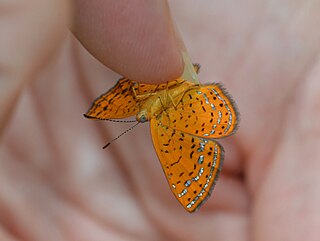
Calephelis muticum, the swamp metalmark, is a butterfly species in the family Riodinidae.

Cupido is a genus of butterflies in the family Lycaenidae. The subgenus Everes is included here.

Gnophos is a genus in the geometer moth family (Geometridae). A mostly Old World lineage, it is abundant in the Palearctic, with some North American species as well; in Europe six species are recorded. This genus has about 120 known species altogether in several recognized subgenera, with new ones still being discovered occasionally.
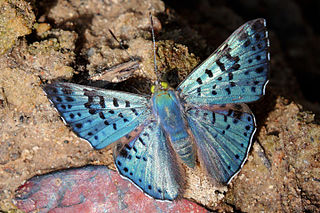
Lasaia agesilas, the glittering sapphire, black-patch bluemark or Narses metalmark is a metalmark butterfly. The species was first described by Pierre André Latreille in 1809. It is native to Central America and the north of South America. It ranges from Costa Rica, Panama, Venezuela, Trinidad, Colombia, Ecuador, Peru, Bolivia, Guyana, Argentina, to the Brazilian Amazon.
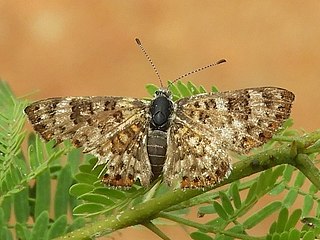
Apodemia walkeri, commonly known as Walker's metalmark, is a species of butterfly in the family Riodinidae (metalmarks), in the superfamily Papilionoidea. The species was described by Frederick DuCane Godman and Osbert Salvin in 1886. It is found from north-western Costa Rica north through Mexico. It is an occasional visitor to the lower Rio Grande Valley in southern Texas. The habitat consists of subtropical scrubs and forests.
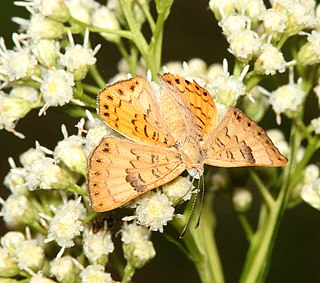
Apodemia zela, the zela metalmark, is a species of metalmark in the butterfly family Riodinidae. It is found in North America.
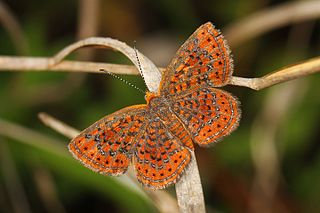
Calephelis virginiensis, the little metalmark, is a species of metalmark in the butterfly family Riodinidae. It is found in North America.

Apodemia hepburni, or Hepburn's metalmark, is a species of metalmark in the family of butterflies known as Riodinidae. It is found in North America.

Apodemia nais, the nais metalmark, is a species of metalmark in the family of butterflies known as Riodinidae. It is found in North America.

Apodemia mejicanus, the Mexican metalmark or Sonoran metalmark, is a species of butterfly in the family Riodinidae. It was first described by Hans Hermann Behr in 1865. It is found in North America.

Apodemia duryi, known generally as the Organ Mountain metalmark or Mexican metalmark, is a species of metalmark in the butterfly family Riodinidae.
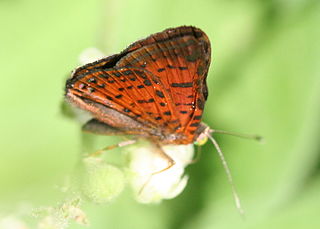
Caria ino, the red-bordered metalmark, is a species of metalmark in the butterfly family Riodinidae. It is found in North America.

Lasaia is a genus of metalmark butterflies in the family Riodinidae. The genus was erected by Henry Walter Bates in 1868. There are about 13 described species in Lasaia, found in North, Central, and South America.
















